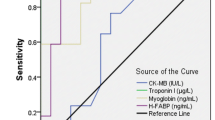Abstract
Currently employed markers for the detection of acute coronary syndrome are Troponin T, CK (Creatine Kinase) and CKMB activity. CKMB activity measured by immunoinhibition method can give falsely elevated results due to the presence of atypical CK and CKBB and at times lead to the mis-diagnosis of acute coronary syndrome. Hence, CKMB mass (CKMB) measured by electrochemiluminence sandwich principle was employed. In this cross-sectional study 183 samples of 61 patients were analyzed within 6 h of diagnosis of acute coronary syndrome and followed up to 72 h. The correlation coefficient between CKMB activity and CKMBM at 4–6 h was 0.744, while at 12–24 h it was 0.909 and at 48–72 h it was 0.337. Thus there was good association between the two methods at 12–24 h but, statistically for method comparison studies and for replacing one method by another, the two methods need to be in agreement with one another. In this study the two methods are not in agreement with one another and thus analytically not replaceable. Another finding was obtained that CKMBM reached cut off levels prior to CKMB enzyme activity and hence, CKMBM is clinically better than CKMB activity to detect reinfarction.



Similar content being viewed by others
References
WHO. Shaping the future. The WHO Health Report. 2003.
Martiniuk AL, Lee CM, Ueshima H, Suh I, Lam TH, Gu D, et al. Hypertension: its prevalence and population-attributable fraction for mortality from cardiovascular disease in the Asia-Pacific region. J Hypertens. 2007;25(1):73–9.
Ghaffar A, Reddy KS, Singhi M. Burden of non-communicable diseases in South Asia. Br Med J. 2004;328(7443):807–10.
Gupta R, Misra A, Pais P, Rastogi P, Gupta VP. Correlation of regional cardiovascular disease mortality in India with lifestyle and nutritional factors. Int J Cardiol. 2006;108(3):291–300.
Thygesen K, Alpert JS, White HD. Universal definition of myocardial infarction. Circulation. 2007;116(22):2634–53.
Christenson RH, Morrow DA, Cannon CP, Jesse RL, Newby LK, Ravkilde J, et al. National academy of clinical biochemistry laboratory medicine practice guidelines: clinical characteristics and utilization of biochemical markers in acute coronary syndromes. Clin Chem. 2007;53(4):552–74.
Szasz G, Gerhardt W, Gruber W. Creatine Kinase in serum : effect of thiols on isoenzyme activity during storage at various temperatures. Clin Chem. 1978;24(9):1557–63.
Perry B, Doumas B, Jendrzejczak B. Effect of light and temperature on the stability of creatine kinase in human sera and controls. Clin Chem. 1979;25(4):625–8.
Panteghini M, Bais R, van Solinge WW. Enzymes, chapter 21. In: Burtis CA, Ashwood ER and Bruns DE, editors. Tietz Textbook of Clinical Chemistry and Molecular Diagnostics. 4th ed. St. Louis: WB Saunders, Elsevier Inc; 2006. p. 597–601
Sax SM, Moore JJ, Giegel JL, Welsh M. Further observations on the incidence and nature of Creatine Kinase activity. Clin Chem. 1979;25(4):535–41.
Serdar MA, Tokqoz S, Metinyurt G, Tapan S, Erinc K, Hasimi A, et al. Effect of macro-creatine kinase and increased creatine kinase BB on the rapid diagnosis of patients with suspected acute myocardial infarction in the emergency department. Mil Med. 2005;170(8):648–52.
Cardiovascular Diseases, chapter 5. In: J.Wallach, editors. Interpretation of diagnostic tests. 8th ed Lippincott Williams and Wilkins; 2007. p. 126–128.
Kemp M, Donovan J, Higham H, Hooper H. Biochemical markers of myocardial injury. Br J Anaesth. 2004;93(1):63–73.
Eisenberg PR, Shaw D, Schaab C, Jaffe AS. Concordance of creatine kinase—MB Activity and Mass. Clin Chem. 1989;35(3):440–3.
Seo H, Miyazaki S, Furuno T, Nonogi H, Haze K, Hiramori K. Creatine Kinase MB protein mass is a better indicator for the assessment of Acute myocardial infarction in the lowere range of Creatine Kinase level. Japanese Heart J. 1993.p. 717–727.
Bland JM, Altman DG. Statistical methods for assessing agreement between two methods of clinical measurement. Lancet. 1986;1(8476):307–10.
Bland JM, Altman DG. Applying the right statistics: analyses of measurement studies. Ultrasound Obstet Gynecol. 2003;22(1):85–93.
Bayer PM, Boehm M, Hajdusich P, Hotschek H, Koehn H, Unger W, Wider G. Immunoinhibition and Automated Column Chromatography Compared for assay of Creatine Kinase isoenzyme MB in serum. Clin Chem. 1982;28(1):166–9.
Pudek MR, Jacobson BE. Falsely negative laboratory diagnosis for myocardial infarction owing to the concurrent presence of macro creatine kinase and macro lactate dehydrogenase. Clin Chem. 1982;28:2434–7.
Lederer WH, Gerstbrein HL. Creatine kinase isoenzyme BB activity in serum of a patient with gastric cancer. Clin Chem. 1976;22:1748–9.
Mair J, Artner-Dworzak E, Dienstl A, Lechleitner P, Morass B, Smidt J, et al. Early detection of acute myocardial infarction by measurement of mass concentration of creatine kinase-MB. Am J Cardiol. 1991;68(17):1545–50.
Young GP, Gibler WB, Hedges JR, Hoekstra JW, Slovis C, Aghababian R, et al. Serial Creatine Kinase-MB Results are a sensitive indicator of Acute Myocardial Infarction in chest pain patients with Nondiagnostic Electrocardiograms: The Second Emergency Medicine Cardiac Research group study. Acad Emerg Med. 1997;4:869–77.
Bakker AJ, Gorgels JP, van Vlies B, Koelemay MJ, Smits R, Tijssen JG, Haagen FD. Contribution of creatine kinase MB mass concentration at admission to early diagnosis of acute myocardial infarction. British Heart J. 1994;72:112–8.
Hoshino T, Sakai Y, Yamashita K, Shirahase K, Asaeda A, Kishi K, et al. Development and performance of an enzyme immunoassay to detect creatine kinase isoenzyme MB activity using anti-mitochondrial creatine kinase monoclonal antibodies. Scand J Clin Lab Invest. 2009;69(6):687–95.
Lee KN, Csako C, Bernhardt P, Elin RJ. Relevance of macro creatine kinase type 1 and type 2 isoenzymes to laboratory and clinical data. Clin Chem. 1994;40(7):1278–83.
Fleming JJ, Janardhan HP, Jose A, Selvakumar R. Anomalous Activity Measurements of Creatine (Phospho) Kinase, CK-MB Isoenzyme in Indian Patients in the Diagnosis of Acute Coronary Syndrome. Indian J Clin Biochem. 2011;26(1):32–40.
Author information
Authors and Affiliations
Corresponding author
Rights and permissions
About this article
Cite this article
Marwah, S.A., Shah, H., Chauhan, K. et al. Comparison of Mass Versus Activity of Creatine Kinase MB and Its Utility in the Early Diagnosis of Re-infarction. Ind J Clin Biochem 29, 161–166 (2014). https://doi.org/10.1007/s12291-013-0329-9
Received:
Accepted:
Published:
Issue Date:
DOI: https://doi.org/10.1007/s12291-013-0329-9




